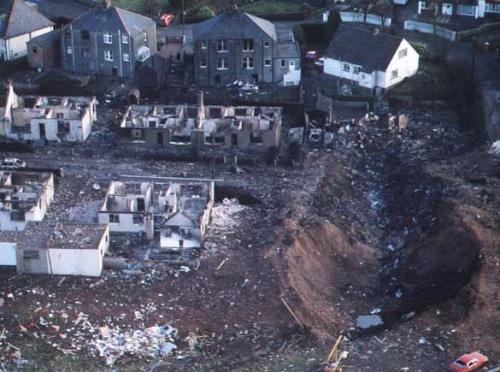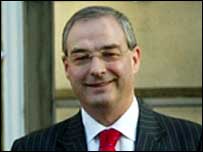Pan Am Flight 103
| A synthesis page at The How, Why and Who of Pan Am Flight 103 summarises the material in this page and other related pages.. |
On 21 December 1988 Pan Am Flight 103, a Boeing 747-121 named "Clipper Maid of the Seas", was on a scheduled transatlantic flight from London Heathrow Airport to New York's John F. Kennedy International Airport when there was an explosion on board. The aircraft broke up over the Scottish town of Lockerbie (Map), killing all 243 passengers and 16 crew members. Eleven people in Lockerbie were killed by large sections of the plane which fell in and around the town, bringing total fatalities to 270.
Thirteen years later, on 31 January 2001, Libyan citizen Abdelbaset Ali Mohmed Al Megrahi was convicted of involvement in the bombing and sentenced to life imprisonment in Scotland. His co-defendant, Lamin Khalifah Fhimah, was unanimously acquitted. Megrahi's appeal against his conviction in January 2001 was refused on 14 March 2002 by a panel of five Scottish judges at Camp Zeist in the Netherlands.[1]
In June 2007, Megrahi was granted leave for a second appeal against his conviction, on the basis of evidence that a miscarriage of justice could have occurred. [2] His appeal to the Court of Criminal Appeal was abandoned by al-Megrahi in August 2009, just two days before the Scottish Government released him on compassionate grounds to return to Libya. The stated grounds for release were that he was suffering from terminal prostate cancer and was likely to die within three months.
Contents
Official Narrative
- Full article: Lockerbie Official Narrative
- Full article: Lockerbie Official Narrative
In August 2001, Scottish Lord Advocate Colin Boyd presented what might be considered the definite statement of the Lockerbie Official Narrative at a conference of the International Society for the Reform of Criminal Law (ISRCL):[3] While admitting that "Politics and diplomacy were necessarily interwoven with this case from the start", there is no mention of Bernt Carlsson, UN Commissioner for Namibia, and the evidence presented at the trial is presented as the unvarnished truth. Libyan Abdelbaset Ali Mohmed Al Megrahi, head of security for Libyan Arab Airlines, was determined at the trial to be a member of the Libyan Intelligence Services and of being guilty of the bombing. The narrative is predictably self-congratulatory: "In conclusion, it seems to me to be absolutely right that the investigation of crime and the prosecutorial decisions which flow from that investigation must be taken independently of political influence... Political and diplomatic action secured the trial. The investigation of the case and the prosecution of the trial were driven by the evidence."
Geopolitical Background
At the time of the attack:
- UK-US relations with Libya were icy over alleged Libyan sponsorship of terrorism and its stubborn refusal to 'see things the West's way'.
- UK-US relations with Iran were slated for improvement following the cessation of the Iran Iraq war in which both sides had been armed by the West.
- On 3 July 1988 Iran Air Flight 655, a civilian Airbus A300 airliner en-route from Bandar Abbas, Iran to Dubai, UAE was brought down by a missile fired by the US Navy guided missile cruiser USS Vincennes, with the loss of 290 lives. The US government claimed that the Airliner had been mistaken for an attacking F14 Tomcat fighter.
The Investigation
The people and organisations involved
- Vincent Cannistraro - CIA task force officer in the brutal 1980s Iran-Contra campaign. Deployed a training manual of invasion and killing of Nicaraguan citizens and officials. Wrote "the anatomy of a lie" to cover up US government involvement in Nicaragua. In 1986 was commissioned by the US President to "Destabilize Libya and destroy the Gaddafi regime". Secretly worked to arm the Afghanistan Mujahadeen and Osama Bin Laden. His chief Admiral Poindexter chaired a top-level meeting - to which Cannistraro had access - to discuss the manufacture of evidence to destabilize the government of Yemen. He was head of the CIA Lockerbie team, but did not attend the trial to give evidence.
Investigation anomalies
The Trial
Geopolitical Background
- UK-US relations with Libya were being 'normalised' following Libya's agreement to extradite al-Megrahi for trial and its abandonment of its allegedly belligerent stance over previously core issues of policy on trade, oil and support for groups antagonistic to Western interests. The accommodation resulted in the lifting of UN trade sanctions against Libya which had progressively paralyzed its economy over the preceding decade.
- UK-US relations with Iran were close to all-time lows and deteriorating over the usual issues of Iranian refusal to 'see things the West's way'
Personalities central to the prosecution's case
- Tony Gauci - The crown's star witness, a Maltese shopkeeper, reportedly paid a large amount by the CIA[4]
- Thomas Thurman - FBI Laboratory 'scientist'
- Alan Feraday - Former head of the forensic laboratory at Royal Armaments Research and Development Establishment (RARDE) at Fort Halstead.
- Dr Thomas Hayes - Over the 1970s and early 1980s progressed to head the RARDE forensic laboratory. His testimony was central to the Lockerbie verdict. Yet he and two colleagues conspired to with-hold evidence from the 1974 alleged IRA Maguire Seven trial which would have indicated innocence. The Maguires were freed on appeal after fifteen years in jail. This matter was exposed in the Lockerbie trial, but the judges trusted Hayes' word implicitly.
Evidence withheld or not available at the time of the trial
- Former CIA agent, Robert Baer, CIA Middle Eastern specialist, worked on the early stages of the investigation. He has repeatedly claimed that, in 1989, there was "Grade A intelligence" held by America to prove that Iran requested and paid for the Lockerbie bombing. If Baer is correct, then the bomb timer fragment which pointed to Libya must have been planted.
- Lord Peter Fraser, Scotland's Chief Law Officer during the investigation and indictments, claimed in 1991 that witnesses would "prove the case beyond reasonable doubt." In 2005 he admitted to journalists that his chief witness Gauci was highly unreliable. Then in 2008, when questioned by a Times journalist, Fraser indicated suspicions that key evidence might have been planted with the knowledge of the CIA.
- Shukri Ghanem, Libyan Prime Minister 2003 - 2006, has said, on at least two occasions in radio and television interviews, that Libya was not responsible and it paid the $2.7 billion compensation with great reluctance and only "to buy peace and move forward."
- The alleged bomb timer fragment: Was it planted to frame Libya for the crime? The fragment's label had been altered by unknown persons. And its finding and examination by Dr Thomas Hayes proved highly suspicious. A series of scientific tests in 2009 have proved that its survival two centimetres from the centre of a high explosive fireball was impossible.[5]
Post-Trial developments
Cameron's Report on Forensic Evidence
- Full article: Cameron's Report on Lockerbie Forensic Evidence
- Full article: Cameron's Report on Lockerbie Forensic Evidence
[[File:Dr_John_
- ↑ "UN monitor decries Lockerbie judgement"
- ↑ File:SCCRC-Lockerbie.pdf - SCCRC Leave to appeal decision press release - June 2007
- ↑ "The Lockerbie Trial" by Rt Hon Colin Boyd QC, Lord Advocate, Scotland
- ↑ http://www.heraldscotland.com/revealed-cia-offered-2m-to-lockerbie-witness-and-brother-1.866400
- ↑ The two key elements of al-Megrahi's conviction



